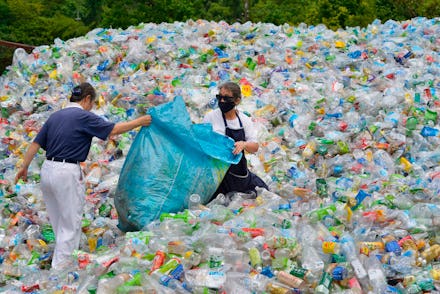A poop study finds plastic in our bodies — and doctors are concerned

The war on single-use plastic straws and grocery bags continues, but the problem of plastic pollution isn’t going away any time soon. Recent reports of microplastic — tiny particles of the material — have identified them in everything from table salts to a number of beloved American beers. Another report sampling popular water bottle brands found that 90% of them contained pieces of plastic, estimating some 10 particles per liter on average, though an exact number can’t be identified as some particles are too small to be detected. Now, that plastic is showing up in people’s poop.
A new study that tested stool samples of eight individuals from countries across the globe, including Italy, Japan, the United Kingdom, Austria, Finland, the Netherlands, Poland and Russia, revealed evidence of microplastics in every sample tested. Up to nine different types of plastic were discovered across the samples, with the most common types being polypropylene, used to produce things like floor coverings and bedding, and polyethylene terephthalate, used to make clothing and beverage containers.
Plastic can come from a variety of sources, most notably from pollution entering our oceans and waterways by way of untreated sewage, industrial production or simple littering. These plastics break down into small particles over time, eventually entering our food supply when ingested by marine life.
“This is the first study of its kind and confirms what we have long suspected, that plastics ultimately reach the human gut,” Philipp Schwabl, the lead researcher of the study said during a presentation of his findings at a European conference. “While the highest plastic concentrations in animal studies have been found in the gut, the smallest microplastic particles are capable of entering the bloodstream, lymphatic system and may even reach the liver. Now that we have first evidence for microplastics inside humans, we need further research to understand what this means for human health.”
While research is limited, doctors are still concerned about plastic’s developmental effects
Apparently, we eat a lot of plastic. A 2017 study found that Americans likely eat at least 660 particles of microplastic each year — and that’s just from salt intake. But research into its effects on human health are limited, Ruairi Robertson, a postdoctoral researcher in studies of the gut at the University of British Columbia, said by phone. Still, it’s worthy of serious concern, he added.
“The studies in animals, for example, have shown that they may be slightly toxic to the liver, they may possibly increase certain chemicals that aren’t great for your brain and it may increase the proliferation of cancer cells, but these have only been done in studies following animals and test-tube studies of human cells,” he said. “But if we do keep accumulating more and more of these plastics in our bodies, any sensible person could speculate that’s not good for our bodies.”
Bisphenol A, or BPA, is a chemical added to create some plastic materials and as a coating on some canned foods. Exposure to it has been found to result in genital deformities and early puberty and may even contribute to obesity and cancer. (A controversial report from September found that supposed “BPA-free” plastic still has serious reproductive concerns.)
Should you avoid seafood at all costs?
Not quite yet, Robertson said.
“People shouldn’t be frightened, but we should all be very aware that clearly there’s way, way too much plastic in our environment and we are hugely overusing single-use plastic,” he said. “Even though we don’t have concrete results of what plastic might be doing to our health, because we don’t know that yet, we do know plastic is damaging our environment and other species and probably damaging our health as well — we need to make a global effort to clamp down on its use.”